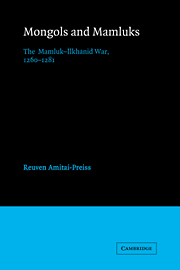Book contents
- Frontmatter
- Contents
- List of illustrations
- Preface
- List of abbreviations
- Notes on dates and transliteration
- Introduction
- 1 The historical background
- 2 The battle of ʿAyn Jālūt
- 3 The formulation of anti-Īlkhānid policy
- 4 The search for a second front
- 5 Military and diplomatic skirmishing
- 6 The secret war
- 7 Baybars's intervention in Seljuq Rūm
- 8 Baybars's posthumous victory: the second battle of Homs (680/1281)
- 9 The Mamluk–Īlkhānid frontier
- 10 Mamluks and Mongols: an overview
- Maps
- Genealogical Tables
- Glossary
- Bibliography
- Index
5 - Military and diplomatic skirmishing
Published online by Cambridge University Press: 23 November 2009
- Frontmatter
- Contents
- List of illustrations
- Preface
- List of abbreviations
- Notes on dates and transliteration
- Introduction
- 1 The historical background
- 2 The battle of ʿAyn Jālūt
- 3 The formulation of anti-Īlkhānid policy
- 4 The search for a second front
- 5 Military and diplomatic skirmishing
- 6 The secret war
- 7 Baybars's intervention in Seljuq Rūm
- 8 Baybars's posthumous victory: the second battle of Homs (680/1281)
- 9 The Mamluk–Īlkhānid frontier
- 10 Mamluks and Mongols: an overview
- Maps
- Genealogical Tables
- Glossary
- Bibliography
- Index
Summary
The people were reassured that the Sultan did not neglect an act, [but rather] carried it out, and he did not abandon his servants. The hearts of the castle defenders were calmed at this, and they said: “The Sultan moves quickly to our aid, and his armies reach the besieging enemy before news [of his approaching armies] comes.”
Ibn ʿAbd al-ẒāhirThe origin of the border war
Already in the first years after the battle of ʿAyn Jālūt, some of the major motifs of the Mamluk–Īlkhānid “cold war” can be discerned: first, and most important, were the raids and other forms of intervention over the border by both sides. Second was the role of the Armenians, active allies of the Mongols, and the subsequent retribution that Baybars exacted from them. Third was the arrival in Syria of Mongol refugees, or wāfidiyya, from Hülegü's army, the first group of which arrived in late 660/1261. These wāfidiyya included both Mongol and indigenous Muslim military elements from Īlkhānid territory, and all were integrated into the Mamluk army. Finally, mention should be made of the role of the Syrian Franks, already discussed in the previous chapter. Throughout his reign, Baybars embarked on a systematic campaign against the Franks whenever lulls in the more pressing war with the Mongols permitted him to do so.
In this chapter, the ongoing, but usually limited, hostilities during the period 1262–77 between the Mamluks on the one hand, and the Īlkhānids and their allies the Armenians on the other, will be presented in a straightforward, chronological narrative.
- Type
- Chapter
- Information
- Mongols and MamluksThe Mamluk-Ilkhanid War, 1260–1281, pp. 106 - 138Publisher: Cambridge University PressPrint publication year: 1995



